I am trying to create a four-panel figure where the bottom-left panel contains a scatter plot, and the other three panels contain histograms. The top-left will be a standard histogram across the x-dimension of the scatter, the bottom-right will be a 90° rotated histogram for the y-dimension. Both of these are easy to do in matplotlib.
I am running into problems with the third histogram, which is to be a 45° rotated plot in the top-right of the figure giving the distribution of the differences between the x and y points. I have made such figures before by manually rotating and rescaling the axes in Illustrator, but it seems like matplotlib should be able to produce figures that are already rotated using the transformation methods on the subplot axes.
I thought something like the following might work:
import matplotlib.pyplot as plt
from matplotlib.transforms import Affine2D
fig, ax = plt.subplots(nrows=2, ncols=2, squeeze=True, sharex=False,
sharey=False, figsize=(8,8))
ax[0,1].text(0.5,0.5,'I should be rotated',ha='center',va='center')
t = ax[0,1].get_transform()
ax[0,1].set_transform(t.transform(Affine2D().rotate_deg(45)))
plt.show()
Here I am attempting to get the transform from the axis, modify it, and then replace it back into the axis object. This code has no effect however. Any help would be greatly appreciated.
Edited based on suggestion from ImportanceOfBeingErnest in comments:
I have taken a look at the Floating Axes demo, and now have this:
from matplotlib.transforms import Affine2D
import mpl_toolkits.axisartist.floating_axes as floating_axes
import matplotlib.pyplot as plt
def setup_axes(fig, rect, rotation, axisScale):
tr = Affine2D().scale(axisScale[0], axisScale[1]).rotate_deg(rotation)
grid_helper = floating_axes.GridHelperCurveLinear(tr, extremes=(-0.5, 3.5, 0, 4))
ax = floating_axes.FloatingSubplot(fig, rect, grid_helper=grid_helper)
fig.add_subplot(ax)
aux_ax = ax.get_aux_axes(tr)
return ax, aux_ax
fig = plt.figure(1, figsize=(8, 8))
axes = []
axisOrientation = [0, 0, 270, -45]
axisScale = [[1,1],[2,1],[2,1],[2,1]]
axisPosition = [223,221,224,222]
for i in range(0, len(axisOrientation)):
ax, aux_ax = setup_axes(fig, axisPosition[i], axisOrientation[i], axisScale[i])
axes.append(aux_ax)
fig.subplots_adjust(wspace=-0.2, hspace=-0.2, left=0.00, right=0.99, top=0.99, bottom=0.0)
plt.show()
This has me closer to what I want:
I will take a shot at adding in the scatter plot and histograms to these axes.

